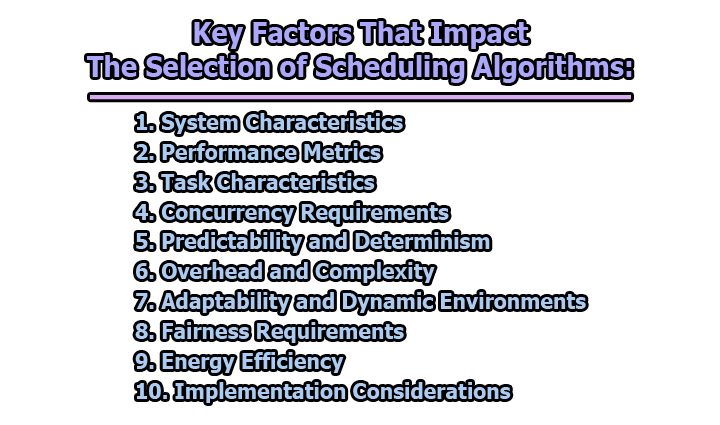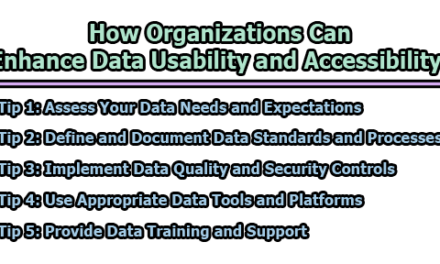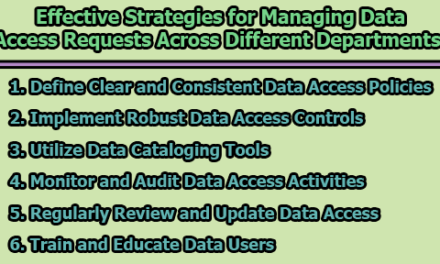Key Factors That Impact the Selection of Scheduling Algorithms:
Scheduling algorithms play an essential role in optimizing resource utilization and enhancing system performance in various computing environments. Whether it’s in operating systems, networking, or manufacturing, selecting the right scheduling algorithm is crucial for achieving desired outcomes efficiently. However, the choice of a scheduling algorithm isn’t arbitrary; it depends on several factors that influence its effectiveness in a given context. In this article, we delve into the key factors that impact the selection of scheduling algorithms, shedding light on the considerations that guide decision-making processes.
1. System Characteristics: The characteristics of the system play a pivotal role in determining the most suitable scheduling algorithm. These characteristics include the type of system (real-time, batch processing, time-sharing), the nature of tasks it handles, resource constraints, and overarching system objectives.
- Real-time Systems: In real-time systems, tasks often have strict deadlines that must be met to ensure system functionality and safety. Scheduling algorithms in real-time systems prioritize tasks based on their deadlines, aiming to minimize the number of missed deadlines and ensure timely execution of critical tasks.
- Batch Processing Systems: Batch processing systems deal with executing a large volume of tasks without immediate user interaction. Here, the focus may be on maximizing throughput or minimizing turnaround time, as the primary goal is to process tasks efficiently in bulk.
- Time-sharing Systems: Time-sharing systems serve multiple users simultaneously by rapidly switching between tasks. In such systems, scheduling algorithms must balance fairness and responsiveness, ensuring that each user receives adequate CPU time and that interactive tasks receive timely responses.
- Resource Constraints: The availability and limitations of system resources, such as CPU, memory, and I/O devices, heavily influence scheduling decisions. Algorithms must allocate resources efficiently to prevent resource contention and ensure optimal system performance.
- System Objectives: The overarching objectives of the system, whether it’s maximizing throughput, minimizing response time, ensuring fairness, or meeting specific service level agreements (SLAs), guide the selection of scheduling algorithms. For example, in a multimedia streaming service, the objective may be to prioritize tasks with stringent latency requirements to deliver smooth playback experiences to users.
Understanding the unique characteristics and requirements of the system is crucial for selecting a scheduling algorithm that aligns with its objectives and optimizes resource utilization.
2. Performance Metrics: Different scheduling algorithms optimize for various performance metrics, and the choice of algorithm depends on the specific goals and priorities of the system. Common performance metrics include throughput, latency, response time, fairness, and resource utilization.
- Throughput: Throughput measures the rate at which tasks are completed or processed by the system. Scheduling algorithms that prioritize throughput aim to maximize the number of tasks executed per unit of time, thereby increasing system efficiency and productivity.
- Latency and Response Time: Latency refers to the time delay between initiating a task and its completion, while response time measures the time taken to respond to a user request. Scheduling algorithms that minimize latency and response time are essential in interactive systems, where users expect prompt feedback and smooth user experiences.
- Fairness: Fairness concerns the equitable allocation of resources among competing tasks or users. Scheduling algorithms that ensure fairness strive to prevent any task or user from being unfairly disadvantaged, thereby promoting a balanced distribution of system resources.
- Resource Utilization: Efficient resource utilization is critical for maximizing the system’s overall performance while minimizing waste. Scheduling algorithms aim to optimize resource utilization by effectively allocating resources to tasks and minimizing idle time.
Different systems may prioritize different performance metrics based on their specific use cases and requirements. For example, a web server may prioritize response time to provide a snappy user experience, while a scientific computing cluster may prioritize throughput to maximize computational throughput.
Understanding the performance goals and priorities of the system is essential for selecting a scheduling algorithm that optimizes the desired performance metrics effectively.
3. Task Characteristics: The characteristics of tasks being processed by the system significantly influence the choice of scheduling algorithm. Task attributes such as computation time, priority levels, dependencies, and resource requirements play a crucial role in determining how tasks are scheduled and prioritized.
- Computation Time: Tasks vary in their computational complexity and execution time, ranging from short CPU-bound tasks to long-running I/O-bound tasks. Scheduling algorithms must take into account the computational requirements of tasks to optimize resource allocation and ensure efficient task execution.
- Priority Levels: Tasks may have different priority levels based on their importance or urgency. Scheduling algorithms that support task priorities ensure that high-priority tasks are executed promptly, allowing the system to meet critical deadlines and service level agreements.
- Dependencies: Some tasks may have dependencies on other tasks, requiring specific ordering or synchronization constraints. Scheduling algorithms must consider task dependencies to avoid deadlock situations and ensure correct task execution order.
- Resource Requirements: Tasks may have varying resource requirements, such as CPU, memory, or I/O bandwidth. Scheduling algorithms must allocate resources efficiently to prevent resource contention and ensure that tasks have access to the resources they need for execution.
Understanding the characteristics of tasks being processed by the system is essential for selecting a scheduling algorithm that can effectively manage task execution and optimize resource utilization.
4. Concurrency Requirements: The degree of concurrency required by the system influences the suitability of scheduling algorithms. Systems with high concurrency requirements, such as multi-core processors or distributed computing environments, require scheduling algorithms that can handle multiple tasks concurrently to fully utilize available resources and maximize system throughput.
- Multi-Core Processors: Multi-core processors enable parallel execution of multiple tasks simultaneously, allowing for increased throughput and performance. Scheduling algorithms for multi-core processors must effectively distribute tasks across CPU cores to maximize parallelism and minimize idle time.
- Distributed Computing: Distributed computing environments involve multiple interconnected nodes working together to process tasks collaboratively. Scheduling algorithms in distributed systems must coordinate task scheduling and resource allocation across nodes to optimize overall system performance and ensure efficient task execution.
- Parallelism and Concurrency: Scheduling algorithms that support parallelism and concurrency are essential for maximizing system throughput and scalability in multi-core and distributed environments. These algorithms enable efficient utilization of available resources and facilitate concurrent execution of tasks to improve system performance.
Understanding the concurrency requirements of the system is crucial for selecting a scheduling algorithm that can effectively exploit parallelism and concurrency to enhance system performance and scalability.
5. Predictability and Determinism: In safety-critical systems or real-time applications, predictability and determinism are paramount. Scheduling algorithms that guarantee bounded response times and provide predictable performance under varying workloads are preferred in such environments, ensuring that deadlines are met consistently.
- Safety-Critical Systems: Safety-critical systems, such as aerospace or automotive control systems, have stringent reliability and safety requirements. Scheduling algorithms in safety-critical systems must provide deterministic and predictable behavior to ensure system stability and reliability.
- Real-Time Applications: Real-time applications, such as industrial automation or multimedia streaming, have strict timing constraints that must be met to deliver reliable performance. Scheduling algorithms for real-time applications must guarantee bounded response times and prioritize tasks based on their deadlines to ensure timely execution.
- Predictable Performance: Scheduling algorithms that provide predictable performance under varying workloads enable system designers to analyze and verify system behavior accurately. Predictable performance is essential for ensuring system stability, reliability, and adherence to performance requirements.
Understanding the predictability and determinism requirements of the system is essential for selecting a scheduling algorithm that can meet timing constraints and provide reliable performance in safety-critical and real-time applications.
6. Overhead and Complexity: The overhead imposed by a scheduling algorithm in terms of computational complexity and system resources is another crucial factor influencing selection. While sophisticated algorithms may offer better performance under certain conditions, they might also introduce significant overhead, making them less suitable for resource-constrained environments or systems with limited processing power.
- Computational Complexity: Scheduling algorithms with higher computational complexity require more processing power and system resources to execute. In resource-constrained environments, such as embedded systems or IoT devices, algorithms with lower computational overhead are preferred to minimize resource consumption and ensure efficient operation.
- System Resources: Scheduling algorithms that impose high resource requirements, such as memory usage or system overhead, may not be suitable for systems with limited resources. Algorithms with low overhead are preferred in such environments to optimize resource utilization and ensure smooth system operation.
- Trade-offs: There is often a trade-off between algorithm complexity and performance. While more complex algorithms may offer better performance under certain conditions, they may also introduce overhead that outweighs their benefits. Understanding these trade-offs is essential for selecting a scheduling algorithm that strikes the right balance between performance and resource utilization.
7. Adaptability and Dynamic Environments: Systems operating in dynamic environments where workload characteristics change over time require scheduling algorithms that can adapt accordingly. Adaptive or self-adjusting algorithms that dynamically respond to workload variations and optimize scheduling decisions in real-time are favored in such scenarios.
- Workload Variability: Workload characteristics in dynamic environments can vary significantly over time, leading to fluctuations in resource demand and system load. Scheduling algorithms must be able to adapt to these changes and dynamically adjust scheduling decisions to optimize system performance.
- Adaptive Algorithms: Adaptive scheduling algorithms monitor system conditions and workload characteristics in real-time, adjusting scheduling decisions based on current conditions. These algorithms can improve system responsiveness, resource utilization, and overall performance in dynamic environments.
- Self-Adjusting Policies: Scheduling algorithms with self-adjusting policies automatically tune their parameters or adjust scheduling strategies based on observed system behavior. Self-adjusting algorithms can adapt to changing workload patterns and optimize scheduling decisions without manual intervention, making them well-suited for dynamic environments.
- Robustness: Adaptive scheduling algorithms must be robust to handle unexpected changes or anomalies in workload patterns. Robust algorithms can effectively cope with fluctuations in system load and maintain stable performance under varying conditions.
Understanding the adaptability requirements of the system is essential for selecting a scheduling algorithm that can effectively respond to changing workload patterns and optimize system performance in dynamic environments.
8. Fairness Requirements: Fairness considerations arise in systems where multiple users or tasks compete for resources. Scheduling algorithms that ensure fairness by allocating resources equitably among competing entities are essential in shared-resource environments to prevent starvation and ensure a satisfactory user experience.
- Resource Allocation: Fair scheduling algorithms allocate system resources in a manner that ensures each task or user receives a fair share of resources over time. Fairness criteria may vary depending on the specific requirements of the system, but common approaches include proportional fairness, max-min fairness, and weighted fairness.
- Preventing Starvation: Fair scheduling algorithms prevent any task or user from being indefinitely starved of resources by ensuring that all entities receive opportunities for resource allocation. Starvation avoidance mechanisms, such as priority aging or resource reservation, may be incorporated into scheduling algorithms to guarantee fairness.
- Enforcing Service Level Agreements (SLAs): Fair scheduling algorithms help enforce service level agreements (SLAs) by ensuring that all tasks or users receive adequate service according to predefined criteria. SLA-aware scheduling algorithms prioritize tasks based on their SLA requirements, ensuring that critical tasks receive preferential treatment when necessary.
- User Satisfaction: Fair scheduling algorithms contribute to user satisfaction by providing a consistent and equitable user experience. Users are more likely to be satisfied with the system when they perceive that resources are allocated fairly and that their tasks receive fair treatment compared to competing entities.
Understanding the fairness requirements of the system is essential for selecting a scheduling algorithm that can allocate resources equitably and prevent starvation while ensuring a satisfactory user experience for all users.
9. Energy Efficiency: With the increasing emphasis on energy conservation and sustainability, scheduling algorithms that prioritize energy efficiency have gained prominence. Algorithms that minimize power consumption by intelligently scheduling tasks and optimizing resource allocation contribute to reducing the environmental footprint of computing systems.
- Dynamic Voltage and Frequency Scaling (DVFS): Energy-efficient scheduling algorithms leverage DVFS techniques to adjust CPU voltage and frequency dynamically based on workload characteristics. By operating CPUs at lower voltages and frequencies during periods of low activity, energy-efficient algorithms reduce power consumption without sacrificing performance.
- Task Consolidation and Migration: Energy-efficient scheduling algorithms optimize resource allocation by consolidating tasks onto fewer resources and migrating idle or underutilized resources into low-power states. By minimizing the number of active resources and maximizing resource utilization, these algorithms reduce overall energy consumption in the system.
- Idle Power Management: Energy-efficient scheduling algorithms minimize idle power consumption by identifying and reducing idle periods in the system. Techniques such as task prefetching, speculative execution, and workload scheduling can help overlap computation with idle periods, reducing overall energy waste.
- Green Scheduling Policies: Green scheduling algorithms prioritize energy-efficient resources or scheduling decisions to minimize energy consumption in data centers or cloud computing environments. These algorithms consider factors such as renewable energy availability, cooling efficiency, and workload characteristics to optimize energy usage while meeting performance requirements.
Understanding the energy efficiency requirements of the system is essential for selecting a scheduling algorithm that can minimize power consumption and reduce the environmental impact of computing operations.
10. Implementation Considerations: Practical considerations such as algorithm complexity, ease of implementation, availability of existing libraries or frameworks, and compatibility with existing system architecture also influence the selection of scheduling algorithms. Choosing algorithms that align with development resources, expertise, and project timelines is crucial for successful implementation.
- Algorithm Complexity: The complexity of the scheduling algorithm influences implementation efforts, development time, and maintenance overhead. Simple algorithms may be easier to implement and debug, while more complex algorithms may require specialized expertise and extensive testing.
- Existing Libraries and Frameworks: Availability of existing libraries or frameworks that implement scheduling algorithms can simplify the implementation process and accelerate development efforts. Leveraging well-established libraries or frameworks can reduce development time and ensure compatibility with industry standards.
- Compatibility and Integration: Scheduling algorithms must integrate seamlessly with existing system architecture and infrastructure. Compatibility considerations include interoperability with operating systems, compatibility with hardware platforms, and compliance with industry standards or protocols.
- Development Resources and Expertise: The availability of development resources, expertise, and skills within the development team influences the choice of scheduling algorithm. Algorithms that align with the team’s expertise and development capabilities are more likely to be implemented successfully and maintained effectively over time.
- Project Timelines and Constraints: Project timelines, deadlines, and constraints impact the selection of scheduling algorithms. Algorithms that can be implemented within the allotted time frame and meet project requirements are preferred, even if they may not be the most theoretically optimal solutions.
Considering implementation considerations alongside technical requirements is essential for selecting a scheduling algorithm that can be implemented effectively within the constraints of the project and development environment.
In conclusion, selecting the right scheduling algorithm is a nuanced process that requires a thorough understanding of system requirements, performance goals, and environmental constraints. By considering factors such as system characteristics, performance metrics, task attributes, concurrency requirements, and adaptability, among others, stakeholders can make informed decisions that optimize system performance and resource utilization. Ultimately, the choice of a scheduling algorithm should align with the overarching objectives of the system while balancing considerations of efficiency, fairness, predictability, and adaptability.

Assistant Teacher at Zinzira Pir Mohammad Pilot School and College










